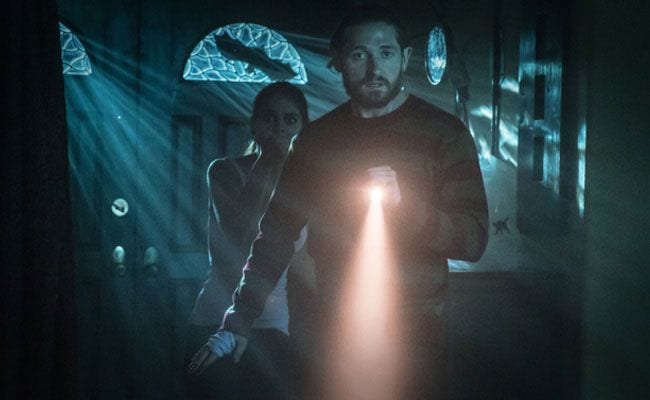
The Tribeca Film Festival typically offers a range of genres. This year, the horror movies presented their own kind of range. On one end, we have Vincent Masciale’s Fear, Inc., drawing from the so-called postmodern model of horror movies that reference themselves. You might recall the moment this model became particularly visible, in 1996, when Kevin Williamson conceived a slasher movie premised on the idea that fans of the genre came in knowing all the rules and tropes. At once mocking and adhering to those rules, Scream, ironically enough, soon swelled into its own four-film franchise while seeming to set these very same conventions in stone.
Fortunately, the slasher film survives, sometimes repetitive and other times clever, simultaneously unoriginal and deconstructed. Unfortunately, is not clever or original. Fear, Inc., which premiered at Tribeca on 15 April, stars Lucas Neff as Joe, a laid-back, hirsute slacker who, in the tradition of TV sitcoms, has somehow managed to attach himself with a stunning fiancée, Lindsey (Caitlin Stasey), whose rich parents provide the couple with a fabulous house up in the Hollywood Hills. Joe has nearly everything he could want, but longs to have his complacency jolted by something exciting. And so he calls the number on a mysterious card he receives from a stranger, setting in motion a home invasion scenario that may or may not be part of an elaborate fabrication that evokes many of the classic horror films Joe and his best friend, Ben (Chris Marquette), are constantly referencing.
Masciale’s film cops a great deal of its plot and approach from The Game, in which Michael Douglas and the audience shared in misconceptions and guesses about what might be “real”. Of course, this allusion isn’t lost on Joe, who compares his experience to David Fincher’s film repeatedly, to the point that his own film is undermined. Joe spends the first two thirds of Fear, Inc., laughing at everyone and congratulating the ghoulish home invaders for making everything seem so “real”. When he finally starts believing what’s happening — shortly after being forced to enact a Saw-inspired hacksaw job on Ben’s wrist — the proceedings still lack conviction. Shortly thereafter, you understand why. By my count, the film manages at least five ties to wrench the audience from one false sense of certainty to another, but by number three, you just don’t care anymore. In this case, familiarity just breeds tedium.

Always Shine
Horror tropes are also on full display in Sophia Takal’s beguiling, twisty psychological thriller, Always Shine, but she has something far more interesting and complex in mind than just playing with an audience’s sense of trust. The film features two young actresses who are old friends. Beth (Caitlin FitzGerald), pretty and demure, is entering a new phase in her career, which is beginning to take off, albeit in a series of predictable slasher films where she often appears nude. More fiery and more talented than Beth, Anna (Mackenzie Davis) still finds herself at the bottom rung of the success ladder.
The two friends spend a weekend up at Big Sur, in a beautiful vacation home belonging to Anna’s family. Ostensibly, the weekend is about the women reconnecting, but it’s fairly clear early on that significant tension exists between the two. Anna laments the course of her life, wondering whether she’ll ever be able to succeed as an actor. Beth plays it off as if she’s embarrassed about her burgeoning fame, but she has a way of humblebragging — during one conversation with Anna, she happens to be holding a Hollywood film magazine that features her in a lead article — and she keeps undermining her friend’s ambitions.
In the horror genre, two beautiful young actresses alone in an isolated cabin always leads to violence. Just so, Always Shine delivers a creepy wind chime soundtrack, part of a low-rumbling, unnerving ambience that would make David Lynch proud. Moreover, a series of unsettling cuts display brief images of future events prepare the audience for plot turns. The tension between the women mounts in a scene in a nearby upscale bar when Beth knowingly steals away the attention of a handsome potential suitor away from Anna, even though she already has a doting live-in boyfriend. Such plot points underline the pair’s similarity, until they become almost interchangeable, as the film plays with the idea of identity, at times recalling Persona.
More often, though, Takal’s film is shaped by the idea of the gendered, male-imagined gaze. The opening scene has Beth auditioning for an all-male crew, reading a piece about taking her clothes off to pacify an assailant, and later scenes have the eyeballing each other with growing discontent and bitterness. Other gazes in Always Shine remain more esoteric. You’re left with an ending that might be seen as either disappointingly inconclusive or wonderfully evocative, depending on your perspective.
Both Fear, Inc. and Always Shine want to explore audience expectations within the possibilities of horror. But Takal’s vastly superior film uses confoundments to dig into the idea of identity politics, as Anna and Beth ponder one another, while Masciale’s doesn’t give Joe much chance to know who he is, as he remains too dim and unmotivated to understand his own or anyone else’s intentions.

